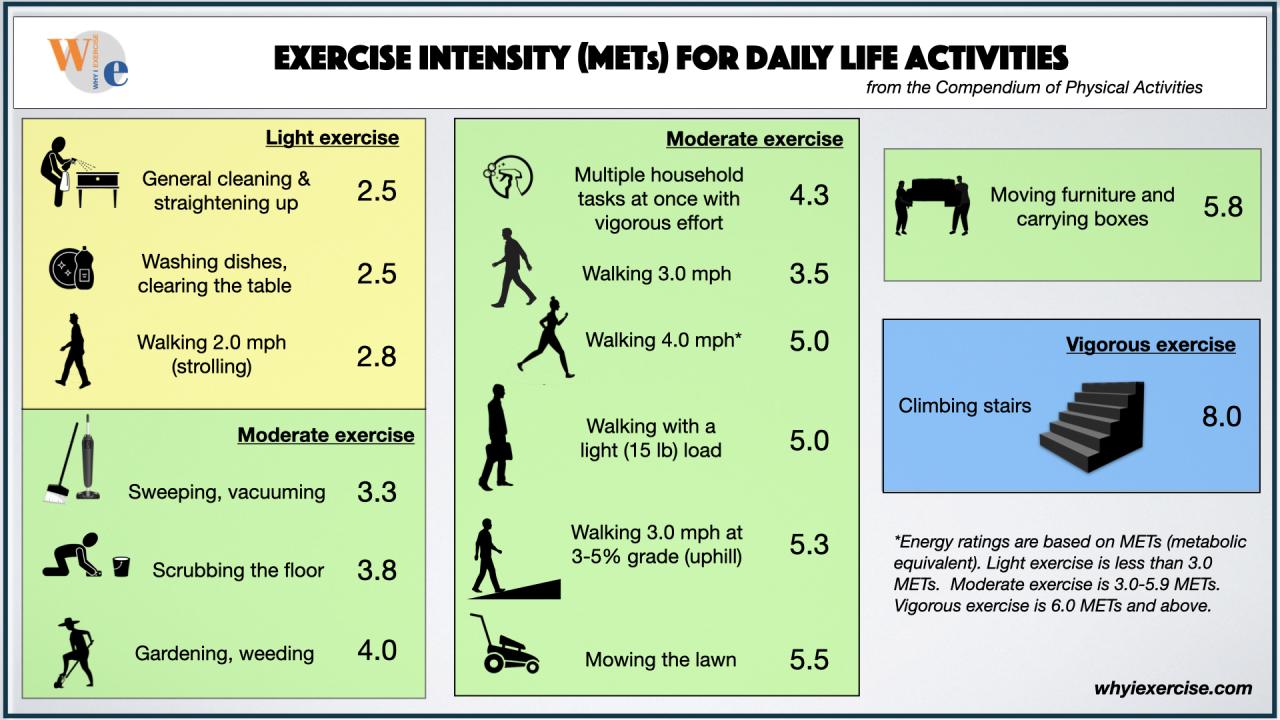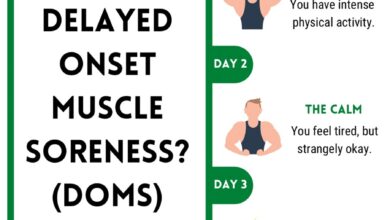
How METs Can Help Measure Workout Intensity
How METs can help measure workout intensity is a question that often arises when individuals are trying to understand the intensity of their workouts and make sure they’re pushing themselves enough to see results. METs, or metabolic equivalents, are a measure of energy expenditure and can be used to determine the intensity of various physical activities.
They provide a standardized way to assess how much energy your body is burning during exercise, regardless of your age, fitness level, or body weight.
By understanding METs, you can choose activities that align with your fitness goals, whether you’re looking for a light cardio session, a challenging strength training workout, or something in between. This knowledge empowers you to create a personalized workout plan that meets your needs and helps you achieve your desired level of fitness.
Using METs to Determine Workout Intensity
METs, or metabolic equivalents, provide a standardized way to measure the intensity of physical activity. Understanding METs can help you tailor your workouts to achieve your fitness goals.
Relationship Between METs and Heart Rate
METs are directly related to your heart rate. A higher MET value indicates a more vigorous activity and a higher heart rate. The relationship between METs and heart rate is not linear, but it is a good indicator of the intensity of your workout.
For example, a light-intensity activity like walking at a moderate pace might have a MET value of 3.0, while a vigorous activity like running might have a MET value of 8.0.
Calculating Target Heart Rate Zones Using METs
You can calculate your target heart rate zones based on your age and desired intensity level using METs. Here’s how:
- Determine your maximum heart rate (MHR) by subtracting your age from 220. For example, if you are 30 years old, your MHR would be 190 (220
30 = 190).
- Multiply your MHR by the desired intensity level (expressed as a percentage). For example, if you want to exercise at a moderate intensity level (50-70% of your MHR), you would multiply your MHR by 0.5 and 0.7, respectively. This gives you a target heart rate range of 95-133 beats per minute (bpm) for a 30-year-old individual.
METs (Metabolic Equivalent of Task) are a great way to gauge the intensity of your workouts, but sometimes you just need a delicious reward after a good sweat session. If you’re looking for a guilt-free treat, check out 11 healthy pizzas under 400 calories for some satisfying options.
Remember, a balanced lifestyle includes both exercise and enjoying your favorite foods in moderation, so you can reach your fitness goals while still savoring the good things in life.
- Use the MET value of the activity to determine your heart rate during the activity. You can use a heart rate monitor or a chart to estimate your heart rate based on the MET value.
Choosing Activities Based on Desired Intensity Levels
You can use METs to choose activities that align with your desired intensity levels.
- Light intensity(1.5-2.9 METs): Activities like walking at a slow pace, light gardening, or doing light housework. These activities are ideal for beginners or for days when you want a low-impact workout.
- Moderate intensity(3.0-5.9 METs): Activities like brisk walking, cycling at a moderate pace, swimming laps, or dancing. These activities are suitable for most individuals and help improve cardiovascular health.
- Vigorous intensity(6.0 METs or higher): Activities like running, jogging, jumping rope, or playing high-impact sports. These activities provide a high-intensity workout and are beneficial for building muscle and improving endurance.
Benefits of Measuring Workout Intensity with METs: How Mets Can Help Measure Workout Intensity

Tracking your workout intensity using METs provides valuable insights into your fitness journey. METs help you understand how hard you’re working, allowing you to tailor your workouts for optimal results.
Knowing your METs can help you tailor your workouts for optimal results. After a great workout, you’ll need to refuel with the right foods to ensure your body recovers and you feel satisfied. Check out this RD approved approach to eating for fullness and satisfaction for some tips.
By tracking your METs and fueling your body properly, you can achieve your fitness goals and enjoy a healthy lifestyle.
Understanding Workout Intensity, How mets can help measure workout intensity
METs are a standardized measure of the energy expenditure during physical activity. They are a ratio of the energy used during an activity compared to the energy used at rest. A MET is equal to the amount of energy you use while sitting quietly.
For example, a MET value of 3 means that an activity requires three times the energy expenditure of sitting at rest. Using METs allows you to measure your workout intensity and helps you achieve your fitness goals in a safe and effective manner.
Benefits of Using METs
Tracking your workout intensity using METs offers numerous benefits:
- Personalized Workout Plans:METs help you create personalized workout plans that are tailored to your fitness level and goals. By understanding the intensity of different activities, you can choose exercises that challenge you without overexerting yourself.
- Progress Tracking:METs allow you to track your progress over time. As you get fitter, you’ll be able to sustain higher MET levels for longer periods. This progress can motivate you to continue your fitness journey.
- Safety:METs can help you avoid overtraining or injuries. By understanding the intensity of your workouts, you can gradually increase the duration and intensity of your exercise sessions.
- Improved Health:Regular exercise at moderate to vigorous intensity (4 to 7 METs) can significantly improve your overall health and well-being.
Examples of MET-Based Workout Plans

METs can be a helpful tool for creating workout plans tailored to your fitness level. By adjusting the intensity and duration of your workouts based on MET values, you can achieve your fitness goals while staying within your comfort zone.
METs, or metabolic equivalents, are a great way to gauge workout intensity, and understanding your METs can be especially helpful if you’re an athlete looking to lose weight. By accurately measuring your workout intensity, you can better track your calorie burn and adjust your training plan accordingly, which can be essential when focusing on calorie cutting for athletes looking to lose weight.
Ultimately, using METs can help you achieve your fitness goals and optimize your weight management strategy.
Sample Workout Plans Using METs
Here are three sample workout plans using METs for different fitness levels:
Beginner (3-5 METs)
| Activity | Duration | METs | Total Calories Burned (Approx.) |
|---|---|---|---|
| Walking (3 mph) | 30 minutes | 3.5 | 150 calories |
| Light Yoga | 30 minutes | 3 | 120 calories |
| Swimming (slow pace) | 20 minutes | 4 | 100 calories |
Intermediate (5-7 METs)
| Activity | Duration | METs | Total Calories Burned (Approx.) |
|---|---|---|---|
| Brisk Walking (4 mph) | 30 minutes | 5 | 210 calories |
| Cycling (10 mph) | 30 minutes | 6 | 250 calories |
| Swimming (moderate pace) | 20 minutes | 6.5 | 160 calories |
Advanced (7-9 METs)
| Activity | Duration | METs | Total Calories Burned (Approx.) |
|---|---|---|---|
| Running (5 mph) | 30 minutes | 8 | 330 calories |
| Swimming (fast pace) | 20 minutes | 8.5 | 210 calories |
| High-Intensity Interval Training (HIIT) | 20 minutes | 9 | 180 calories |
Considerations for Using METs
While METs provide a useful framework for understanding exercise intensity, it’s crucial to remember that they are not a perfect measure for everyone. Several factors can influence MET values and impact the accuracy of this system for individual workouts.
Factors Influencing MET Values
MET values are based on average energy expenditure for specific activities, but individual differences can significantly affect how many calories you burn during exercise.
- Age:As we age, our metabolic rate naturally slows down, meaning we burn fewer calories at rest and during exercise. This means that the same activity might have a lower MET value for an older individual compared to a younger person.
- Fitness Level:Individuals with higher fitness levels tend to be more efficient at using energy, which can result in lower MET values for the same activity compared to those who are less fit. For example, a seasoned runner might burn fewer calories per minute during a jog than someone who is new to running.
- Environmental Conditions:Factors like temperature, humidity, and altitude can influence energy expenditure during exercise. For example, exercising in hot or humid conditions can increase your heart rate and calorie burn, leading to a higher MET value for the same activity.
- Body Weight:Heavier individuals generally burn more calories during exercise, leading to higher MET values. However, this is not always a direct correlation, as body composition (muscle mass vs. fat mass) also plays a role.
Limitations of METs in Measuring Individual Workout Intensity
While METs offer a general guideline for exercise intensity, they have limitations in accurately measuring individual workouts.
- Individual Variability:METs are based on averages, and individual responses to exercise can vary greatly. Two people performing the same activity might experience different levels of exertion and calorie burn.
- Focus on Aerobic Exercise:METs primarily focus on aerobic activities, making them less suitable for measuring the intensity of strength training or other types of exercise. The energy expenditure during strength training can vary depending on factors like weight lifted, sets, and repetitions.
- Lack of Consideration for Intensity Fluctuations:METs are often assigned to activities based on their average intensity. However, many workouts involve varying levels of intensity throughout, making METs less accurate in capturing the true intensity fluctuations.
Consulting a Healthcare Professional
Given the limitations of METs in accurately measuring individual workout intensity, it’s essential to consult a healthcare professional for personalized guidance. They can assess your individual fitness level, goals, and health conditions to recommend appropriate exercise intensity and create a tailored exercise plan.
Concluding Remarks
Measuring workout intensity with METs can be a valuable tool for anyone seeking to improve their fitness and overall health. By understanding how METs relate to energy expenditure and using them to calculate target heart rate zones, you can tailor your workouts to achieve your specific goals.
Remember, consistency is key, so choose activities you enjoy and gradually increase the intensity as you progress. If you have any questions or concerns about your workout intensity, don’t hesitate to consult with a healthcare professional for personalized guidance.





